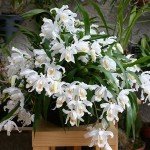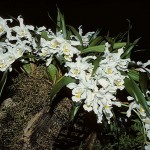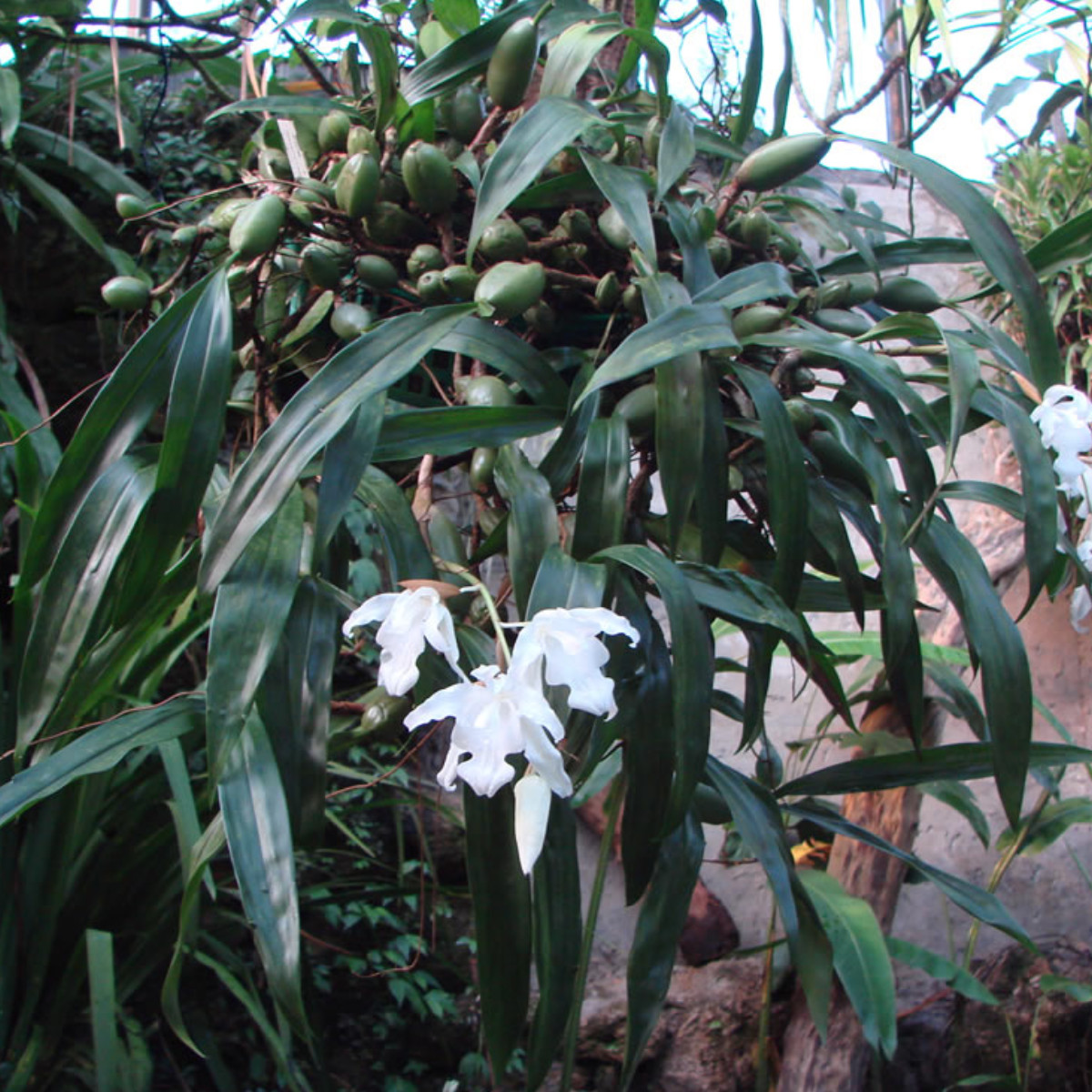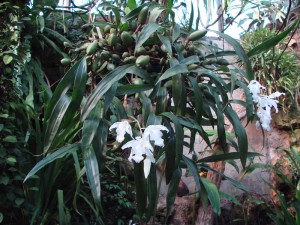Family: Orchidaceae
Synonymous: Cymbidium speciosissimum
Pleione speciosissima
Distribution and habitat: Coelogyne cristata is an evergreen epiphytic orchid that comes from cool, moist areas of the eastern Himalayas and Vietnam. It grows on trees and sometimes rocks in cold high altitude about 1600-2600m (5250-8530 feet) moss-forests where they may experience wet summers and cold winters. Some areas may be quite bright in winter but many areas are covered in fog or cloud and sunlight is much lower. It blooms every spring, before the snow begin to melt.
Description: Coelogyne cristata has a tightly packed cluster of shiny, light green, round or egg-shaped pseudo-bulbs. Each pseudo-bulb is 2-8cm (0.8-3 inch) high and 2-4cm (0.8-1.5 inch) wide. Bulbs that have flowered gradually wrinkle and yellow. The pointed, strap-shaped, usually arching bright green leaves are 15-30cm (6-12 inch) long and 5cm (2 inch) wide. Coelogyne cristata is an unusual Coelogyne in that its 30cm (12 inch) long flower stems rise from the base of the pseudo-bulbs. Each stem carries up to eight roughly bowl-shaped blooms, up to 10cm (4 inch) across. The flower, straw-coloured in bud is entirely white, but five gold yellow lines run down the middle of the broad, three-lobed lip. The fragrant flowers generally appear in winter and early spring and each bloom last several weeks.
Houseplant care: Coelogyne cristata would definitely be the most popular and most widely grown of all the Coelogynes species. Although they are not the easiest orchids to grow indoors, the sheer number of white-and-gold blooms make the prospect of cultivating them quite tempting.
Sticky leaves are normal for this genus. New unfurling leaves are often covered with a sticky sap. It recommended to wash off the sap at some point because it can bind the flower stems that emerge. Take it to the sink to rinse them off, using tepid water.
It only flowers once per year. The bracts (which protect the new baby shoots in nature) stay on the base of shoots and flowers and as the flowers die can look untidy. The same applies to the old flower spikes. Some people prefer to prune them off but this is unnatural.
Light: Give the Coelogyne cristata bright filtered light throughout the year. Do not expose this orchid to direct sunlight.
If it is not available a spot near a window, grow lights work beautifully for these orchids. Use one warm white tube and one cool white tube under a reflector. Place orchids about 20cm (8 inch) beneath the light for 14-16 hours a day. It is also important to give them darkness at night.
Temperature: For Coelogyne cristata temperatures should not exceed 23C (73F). Winter ranges of 13-16C (55-61F) during the day and 7-10C (45-50F) during the night are best, but these orchids can tolerate up to 5C (9F) higher than the ideals.
In the summer, it is permissible to leave them outdoors in partial shade. But, if the temperature is too high, they will not bloom.
Humidity: Coelogyne cristata needs moderate to high around 70-85% during the active growth season and around 50-60% during the rest winter period. To maintain this high humidity use a humidity tray or cool room humidifier. Grouping plants also helps to maintain the moisture in the air around them.
Air circulation: Strong air movement is critically important at all times. Place Coelogyne cristata where it will enjoy plenty of air circulation. Fans are fine, but keep it away from heat or air conditioning vents.
Watering: Coelogyne cristata normally needs a winter rest period for 6 weeks to encourage flower buds. During their active growth period water these plants plentifully, keeping the potting mixture thoroughly moist at all times. During the rest period give them only enough to keep the potting mixture from drying out.
When watering Coelogyne cristata do not let water rest on pseudo-bulbs around the new growth from which flower stem arise. To avoid this risk, stand containers in tepid water below the level of the new growth for 10 minute at a time instead of watering from above.
Coelogynes have water-storing pseudo-bulbs, making them more tolerant of dry soil than wet.
Feeding: Apply foliar feed to actively growing Coelogyne cristata at every second or third watering. It should not receive any more liquid nourishment during the rest period.
Potting and repotting: Use any of recommended potting mixture for orchids. Grow these plants in pots or baskets or attach them to a slab of tree fern.
Allow plenty of space in the containers as Coelogyne cristata dislike being moved and they can usually be left undisturbed for at least four years. Repotting can be delayed by removing groups of the oldest pseudo-bulbs (the dying back-bulbs) from time to time. Use a sharp knife to cut through the rhizome and fill the empty space with potting mixture. In this way the removal of old growth makes room for the new. It should not be repotted until the pot is filled with roots. When repotting must be done, do it in spring shortly after flowering season is over.
Propagation: To propagate, cut off a piece of rhizome bearing at least one new pseudo-bulb and one growing point as well as two or three older pseudo-bulbs. Do this just before the beginning of the flowering season. The largest the section of rhizome removed the better, since small pieces take several years to flower. Pot the rhizome section in recommended orchid potting mixture with this growing point toward the centre of the small pot and water it sparingly till new growth appears.
Problems:
Brown leaf tips can be caused by dry soil, dry air or tap water that contains fluoride, chlorine and salts that accumulate in the potting medium. This build up of soluble salts come from the chemicals in tap water and fertilizers.
Treatment: Use distilled or rainwater and increase humidity if the air is too dry. The excess of salt buildup in the medium which may be remedied by flushing the medium with distilled or rainwater.
These same symptoms may also be caused by root rot resulting from too much water, usually with old, broken-down medium. Root rot is indicated if roots are soft and brown and the root ball will probably fall apart as it is removed from the pot or basket.
Treatment: If this happens, it is obviously past time to repot. Since the plant is already out of the pot, take the opportunity to remove the old medium, clean up and treat the diseased portion of the plant and repot it using new medium and a clean pot.
Coelogyne cristata does not flower.
Treatment: Usually the reason that Coelogyne cristata does not flower is that it is kept too dark. Also this orchid will not flower if it kept in too hot temperatures. Provide adequate growing condition to obtain a proper flowering.
Availability: Coelogyne cristata orchids are available for sale in the winter and spring when most are in bloom.
Uses: This orchid demands to be grown into a specimen size to highlight its beauty.
Also, Coelogyne cristata has high ornamental value as a cut flower lasting for 15 to 60 days.
SUMMARY:
CHARACTERISTICS:
Foliage green
Features flowers, fragrance
Shape bushy
Height: 15-30cm (6-12 inch)
PROPER CARE:
Watering in rest period sparingly
Watering in active growth period plentifully
Light bright filtered
Temperature in rest period min 7C max 16C (45-61F)
Temperature in active growth period min 16C max 24C (61-75F)
Humidity high
Hardiness zone: 10-11






